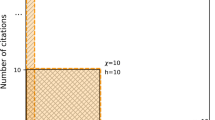Abstract
We propose a two-dimensional bibliometric index that strikes a balance between quantity (as measured by the number of publications of a researcher) and quality (as measured by the number of citations to those publications). While the square of h-index is determined by the maximum area square that fits under the citation curve of an author when plotting the number of citations in decreasing order, the rec-index is determined by the maximum area rectangle that fits under the curve. In this context we may distinguish between authors with a few very highly-cited publications, who may have carried out some influential research, and prolific authors, who may have many publications but fewer citations per publication. The influence of a researcher may be measured via a restricted version of the rec-index, the \({rec}_{I}\)-index, which is the maximum area vertical rectangle that fits under the citation curve. Similarly, the prolificity of a researcher may be measured via the \({rec}_{P}\)-index, which is the maximum area horizontal rectangle that fits under the citation curve. This leads to the proposal of the two-dimensional bibliometric index \(({rec}_{I}, {rec}_{P})\), which captures both aspects of a researcher’s output. We present a comprehensive empirical analysis of this two-dimensional index on two datasets: a large set of Google Scholar profiles (representing “typical” researchers) and a small set of Nobel prize winners. Our results demonstrate the potential of this two-dimensional index, since for both data sets there is a statistically significant number of researchers for whom \({rec}_{I}\) is greater than \({rec}_{P}\). In particular, for nearly 25% of the Google Scholar researchers and for nearly 60% of the Nobel prize winners, \({rec}_{I}\) is greater than \({rec}_{P}\).







Similar content being viewed by others
References
Andersen, J. P., & Haustein S. (2015). Bootstrapping to evaluate accuracy of citation-based journal indicators. In Proceedings of the 15th international society of scientometrics and informetrics conference (pp. 413–414). Istanbul, Turkey.
Bornmann, L., & Daniel, H.-D. (2007). What do we know about the h index? Journal of the American Society for Information Science and Technology, 58, 1381–1385.
Bar-Ilan, J. (2008). Which h-index? A comparison of WoS, Scopus and Google Scholar. Scientometrics, 74, 257–271.
Bar-Ilan, J. (2018). The Journal of Altmetrics is launched—Editorial. Journal of Altmetrics,. https://doi.org/10.29024/joa.5.
Bar-Ilan, J., & Levene, M. (2015). The hw-rank: an h-index variant for ranking web pages. Scientometrics, 102, 2247–2253.
Clarivate Analytics. (2018). Web of science. www.webofknowledge.com.
Davison, A. C., & Hinkley, D. V. (1997). Bootstrap methods and their applications. Cambridge series in statistical and probabilistic mathematics. Cambridge: Cambridge University Press.
Egghe, L. (2006). Theory and practise of the g-index. Scientometrics, 69, 131–152.
Fenner, T., Harris, M., Levene, M., & Bar-Ilan, J. (2018). A novel bibliometric index with a simple geometric interpretation. PLoS ONE, 13(7), e0200098.
Hausken, K. (2016). The ranking of researchers by publications and citations: Using RePEc data. Journal of Economics Bibliography, 3, 530–558.
Hirsch, J. E. (2005). An index to quantify an individual’s scientific research output. Proceedings of the National Academy of Sciences of the United States of America, 98, 16569–16572.
Levene, M., Fenner, T., & Bar-Ilan, J. (2019). Characterisation of the \(\chi\)-index and the \(rec\)-index. Scientometrics, 120, 885–896.
Piwowar, H. (2013). Altmetrics: Value all research products. Nature, 493, 159.
Radicchi, F., & Castellano, C. (2013). Analysis of bibliometric indicators for individual scholars in a large data set. Scientometrics, 97, 627–637.
Rousseau, R., Egghe, L., & Guns, R. (2018). Becoming metric-wise: A bibliometric guide for researchers. Chandos information professional series. Cambridge, MA: Chandos Publishing.
Rosner, B. (2011). Fundamentals of biostatistics (7th ed.). Boston, MA: Brooks/Cole, Cengage Learning.
Sahel, J.-A. (2011). Quality versus quantity: Assessing individual research performance. Science Translational Medicine, 3, 84cm13.
Todeschini, R., & Baccini, A. (2016). Handbook of bibliometric indicators: Quantitative tools for studying and evaluating research. Weinheim: Wiley-VCH.
van Eck, N. J., & Waltman, L. (2008). Generalizing the h- and g-indices. Journal of Informetrics, 2, 263–271.
Woeginger, G. J. (2008). A symmetry axiom for scientific impact indices. Journal of Informetrics, 2, 298–303.
Wildgaard, L., Schneider, J. W., & Larsen, B. (2014). A review of the characteristics of 108 author-level bibliometric indicators. Scientometrics, 101, 125–158.
Author information
Authors and Affiliations
Corresponding author
Additional information
This paper is dedicated to the memory of Judit Bar-Ilan (1958–2019), an outstanding scholar and an inimitable friend and colleague.
Rights and permissions
About this article
Cite this article
Levene, M., Harris, M. & Fenner, T. A two-dimensional bibliometric index reflecting both quality and quantity. Scientometrics 123, 1235–1246 (2020). https://doi.org/10.1007/s11192-020-03454-0
Received:
Published:
Issue Date:
DOI: https://doi.org/10.1007/s11192-020-03454-0




